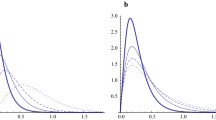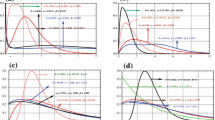Abstract
Because of the dramatic changes that are being observed in the climatic conditions of the world, such as excess of rains, drought and huge floods, we introduce a versatile hydrologic probability model with three parameters. The proposed model is a combination of the Lomax and generalized Weibull distributions based on an exponent odd function. Main properties of the distribution are obtained, such as shapes of the probability density and hazard rate functions, quantile function, asymptotic distribution, information matrix and characterization via hazard rate function. Parameters are estimated via the maximum likelihood estimation method. Four data sets are used to compare the proposed model with a number of well-known hydrologic models. The proposed model is found to be suitable and representative for heavy-tailed hydrological data sets, with least loss of information attitude and a realistic return period.







Similar content being viewed by others
References
Ahmad MI, Sinclair CD, Werritty A (1988) Log-logistic flood frequency analysis. J Hydrol 98:205–224
Akinsete A, Famoye F, Lee C (2008) The beta-Pareto distribution. Statistics 42:547–563
Alves MIG, Haan LD, Neves C (2009) Statistical inference for heavy and super-heavy tailed distributions. J Stat Plan Inf 139:213–227
Balakrishnan N, Leung MY (1988) Means, variances and covariances of order statistics, BLUEs for the Type-I generalized logistic distribution, and some applications. Communications in Statistics Simulation and Computation 17(1):51–84
Bobee B (1975) The log Pearson type 3 distribution and its application in hydrology. Water Resour Res 11(5):681–689
Cakmakyapan S, Ozel G (2016) The Lindley family of distributions: properties and applications. Hacet J Math Stat 46:1–27
Dargahi-Noubary GR (1989) On tail estimation: an improved method. Math Geol 21(8):829–842
Denuit M, Maréchal X, Pitrebois S, Walhin JF (2007) Actuarial modelling of claim counts risk classification, credibility and bonus-malus systems. Wiley, West Sussex
Dyrrdal AV (2012) Estimation of extreme precipitation in Norway and a summary of the state of the art. Report no. 08/2012, Climate, Norwegian Meteorological Institute
Foss S, Zachary S, Korshunov D (2011) An introduction to heavy-tailed and sub-exponential distributions. Springer, New York
Hosking JRM, Wallis JR (1987) Parameter and quantile estimation for the generalized Pareto distribution. Technometrics 29(3):339–349
Hussain T, Bakouch HS, Iqbal Z (2018) A new probability model for hydrologic events: properties and applications. J Agric Biol Environ Stat 23(1):63–82
IPCC (2012) Managing the risks of extreme events and disasters to advance climate change adaptation. Field CB et al (eds) Cambridge University Press
Johnson NL, Kotz S, Balakrishnan N (2005) Continuous univariate distributions, vol 1, 2nd edn. Wiley, New York
Junior PWM, Johnson ES (1973) Three parameter kappa distribution maximum likelihood estimates and likelihood ratio tests. Mon Weather Rev 101(09):701–711
Krige D (1960) On the departure of ore value distributions from the log-normal model in South African gold mines. J South Afr Inst Min Metall 40(1):231–244
Leadbetter MR, Lindgren G, Rootzen H (1987) Extremes and related properties of random sequences and processes. Springer, NewYork
Loikith PC, Neelin JD (2015) Short-tailed temperature distributions over North America and implications for future changes in extremes. Geophys Res Lett 42:8577–8585
Lomax KS (1987) Business failures: another example of the analysis of failure data. J Am Stat Assoc 49:847–852
Markovich N (2007) Nonparametric analysis of univariate heavy-tailed data. Wiley, Chichester
Mudholkar GS, Srivastava DK, Kollia GD (1996) A generalization of the Weibull distribution with application to the analysis of survival data. J Am Stat Assoc 91(436):1575–1583
Mujere N (2011) Flood frequency analysis using the Gumbel distribution. Int J Comput Sci Eng 3(7):2774–2778
Papalexiou SM, Koutsoyiannis D, Makropoulos C (2013) How extreme is extreme? An assessment of daily rainfall distribution tails. Hydrol Earth Syst Sci 17:851–862
Pickands J (1975) Statistical inference using extreme order statistics. Ann Stat 3:119–131
R Core Team (2013) R: A language and environment for statistical computing. R Foundation for Statistical Computing, Vienna, Austria. https://www.r-project.org/
Ramos PL, Louzada F, Ramos E, Dey S (2018) The Fréchet distribution: estimation and application an overview. Available at: arXiv:1801.05327v1 [stat.AP]
Rao AR, Hameed KH (2000) Flood frequency analysis: new directions in civil engineering. CRC Press, Florid
Vuong QH (1989) Likelihood ratio tests for model selection and non-nested hypotheses. Econometrica 57(2):307–333
Author information
Authors and Affiliations
Corresponding author
Additional information
Handling Editor: Pierre Dutilleul.
Appendices
Appendix-A
Proof
Necessity:
If \(X\sim LDGW(\lambda ,\theta ,\beta )\), with a cdf defined by Equation (1), then its hrf can be expressed as
where \(x>0\), \(\lambda \le 0\), \(\alpha >0\) and \(\beta >0\).
Now, differentiating the logarithmic form of the hrf with respect to x, we get
which after some algebraic manipulations we get Equation(8).
Sufficiency:
Suppose Equation(8) holds, then it may be re-written as
From the above differential equation, we have
Integrating the Equation (10) from 0 to x we get
which after simplification yields
This completes the proof. \(\square \)
Appendix-B
and
Appendix-C
See Tables 18,19, 20, 21, 22, 23, 24 and 25.
Rights and permissions
About this article
Cite this article
Hussain, T., Bakouch, H.S. & Chesneau, C. A new probability model with application to heavy-tailed hydrological data. Environ Ecol Stat 26, 127–151 (2019). https://doi.org/10.1007/s10651-019-00422-7
Received:
Revised:
Published:
Issue Date:
DOI: https://doi.org/10.1007/s10651-019-00422-7




